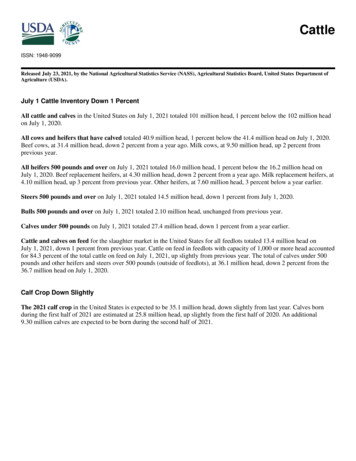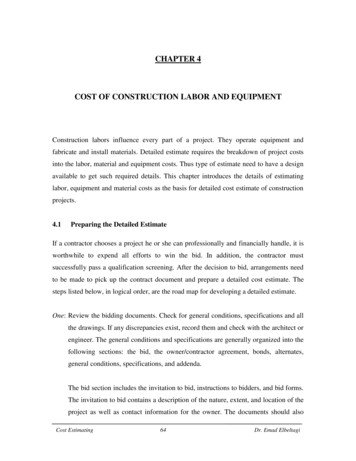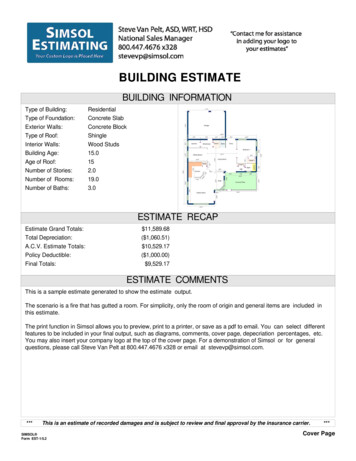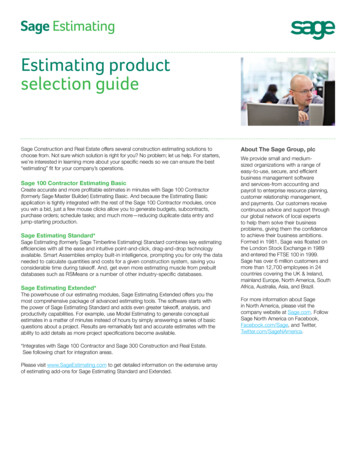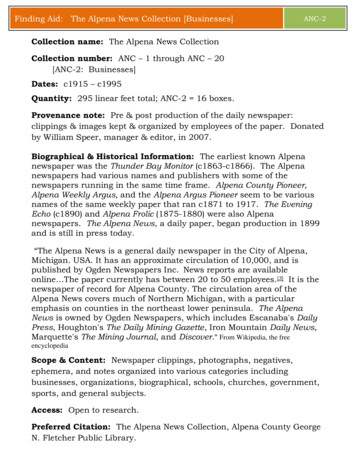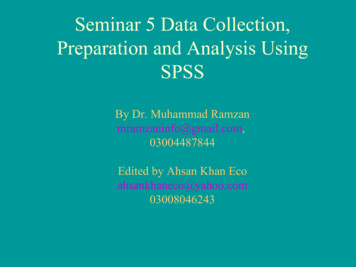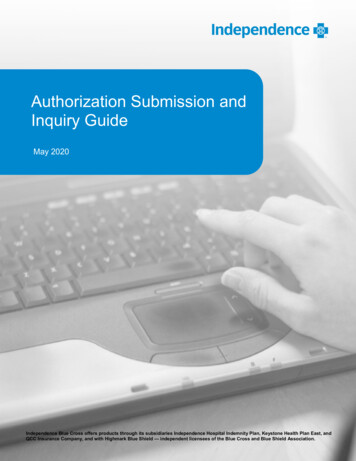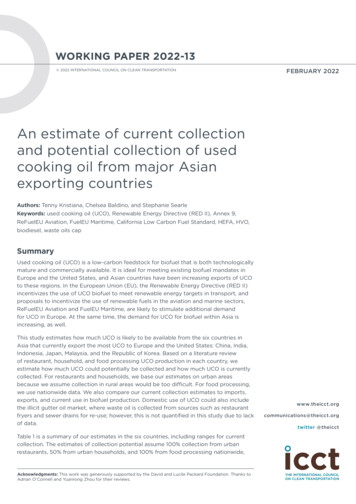
Transcription
WORKING PAPER 2022-13 2022 INTERNATIONAL COUNCIL ON CLEAN TRANSPORTATIONFEBRUARY 2022An estimate of current collectionand potential collection of usedcooking oil from major Asianexporting countriesAuthors: Tenny Kristiana, Chelsea Baldino, and Stephanie SearleKeywords: used cooking oil (UCO), Renewable Energy Directive (RED II), Annex 9,ReFuelEU Aviation, FuelEU Maritime, California Low Carbon Fuel Standard, HEFA, HVO,biodiesel, waste oils capSummaryUsed cooking oil (UCO) is a low-carbon feedstock for biofuel that is both technologicallymature and commercially available. It is ideal for meeting existing biofuel mandates inEurope and the United States, and Asian countries have been increasing exports of UCOto these regions. In the European Union (EU), the Renewable Energy Directive (RED II)incentivizes the use of UCO biofuel to meet renewable energy targets in transport, andproposals to incentivize the use of renewable fuels in the aviation and marine sectors,ReFuelEU Aviation and FuelEU Maritime, are likely to stimulate additional demandfor UCO in Europe. At the same time, the demand for UCO for biofuel within Asia isincreasing, as well.This study estimates how much UCO is likely to be available from the six countries inAsia that currently export the most UCO to Europe and the United States: China, India,Indonesia, Japan, Malaysia, and the Republic of Korea. Based on a literature reviewof restaurant, household, and food processing UCO production in each country, weestimate how much UCO could potentially be collected and how much UCO is currentlycollected. For restaurants and households, we base our estimates on urban areasbecause we assume collection in rural areas would be too difficult. For food processing,we use nationwide data. We also compare our current collection estimates to imports,exports, and current use in biofuel production. Domestic use of UCO could also includethe illicit gutter oil market, where waste oil is collected from sources such as restaurantfryers and sewer drains for re-use; however, this is not quantified in this study due to lackof data.Table 1 is a summary of our estimates in the six countries, including ranges for currentcollection. The estimates of collection potential assume 100% collection from urbanrestaurants, 50% from urban households, and 100% from food processing nationwide,Acknowledgments: This work was generously supported by the David and Lucile Packard Foundation. Thanks toAdrian O’Connell and Yuanrong Zhou for their witter @theicct
based on the idea that collection from businesses like restaurants and food processingplants is easier than from households, especially in large amounts. We also list bothestimates of currently collected UCO and 2019 imports, and compare that with 2019exports and UCO already used in biofuel. The difference between these categoriesis shown in the final column. Note that, due the assumptions made about currentcollection, uses, trade, and lack of data on gutter oil, this work may underestimate oroverestimate any surplus or deficit identified in the final column of the table.Table 1. Summary of estimates of UCO potential, UCO collection, import-export, and biofuel use, in kilotonnes per ollectionCurrentcollection shareof potentialTotal ofestimated currentcollection �4,139IndiaCountryTotal of2019 exports estimated currentbiofuel useNet of 1(65)–(42)Republic of Korea11688–10776%–92%150–169168(18)–1As shown in the final column, China and India might have a UCO surplus, and in Malaysiait might be the opposite, that it exports more UCO than it currently collects. However,any UCO surpluses, particularly in China, India, and Indonesia, might not exist becausethe UCO could be used in the gutter oil market. Studies suggest that gutter oil is aproblem in these three countries, even as their governments try to address it throughthings like a biofuel program or adjusting the market price of cooking oil to increaselegal UCO collection.Our study highlights how there is some room in these UCO-exporting countries forpolicymakers to incentivize increased UCO collection, either for use domestically, suchas in biofuel, or for export. We further estimate that the European Union could demandaround 3,500 kilotonnes of UCO imports in 2030 if a proposed revision to RED II goesinto effect. FuelEU Maritime and ReFuelEU Aviation would further incentivize additionalUCO-based fuels beyond the incentives in RED II. In 2035, for example, the ReFuelEU15% SAF mandate (outside the 5% submandate) could incentivize demand for 5,600kilotonnes of UCO imports. These are a sizeable amount when compared to our totalestimate for current collection in these six countries, which is between 3,700 and 5,000kilotonnes. We therefore suggest the European Union include 1.7% caps on waste oilsin amendments to both ReFuelEU Aviation and FuelEU Maritime, to align with the 1.7%cap on waste oils in RED II. Such caps are reflective of a desire to stimulate other kindsof renewable fuels in addition to those derived from waste oils like UCO, and theirimplementation would support the development of nascent technologies needed toachieve long-term decarbonization of transport.IntroductionUsed cooking oil (UCO) is an excellent low-carbon feedstock for meeting biofuelmandates. It can be used to produce biodiesel, hydroprocessed vegetable oils (HVO),also known as drop-in renewable diesel, and hydroprocessed esters and fatty acids(HEFA), a kind of jet fuel (Kristiana & Baldino, 2021). Because these fuel pathways aretechnologically mature and commercially available, there is strong demand for UCOas a feedstock, especially as many other low-carbon fuel pathways are currently lesstechnologically and commercially mature.2ICCT WORKING PAPER 2022-13 AN ESTIMATE OF USED COOKING OIL FROM ASIAN EXPORTING COUNTRIES
A lot of the UCO imported by the European Union comes from Asia and the UnitedStates, and 68% of total UCO imports in 2019 were from these regions (UN Comtrade,n.d.). Already most of the growing UCO biodiesel production in China is driven bydemand for UCO biodiesel in the European Union, and the demand stems from policyincentives under the Renewable Energy Directive or RED (Greenea, 2021). The RED IIincentivizes the use of waste oils like UCO to help meet a renewable energy target fortransport in 2030, though their contribution is limited to 1.7% of road and rail energy(European Commission, 2021). Proposed changes to RED II and new regulations,however, would also incentivize and mandate renewable fuel in the marine and aviationsectors in the European Union. A proposed revision to the RED means more wasteoil would qualify toward this directive, because it would apply to all transport energy,including the fuel used in the marine and aviation sectors, and thus a greater volume oftransport fuels is under the directive, even though the cap remains at 1.7%. Additionally,two new regulations have been proposed, FuelEU Maritime and ReFuelEU Aviation,and these would incentivize additional UCO-based fuels (European Commission, 2021)beyond the incentives in RED II. Meanwhile, demand for UCO for biofuel productionwithin Asian countries that produce significant amounts of it is also on the rise, andthere are policy incentives in the United States. One U.S. example is California’s LowCarbon Fuel Standard (LCFS), which is designed to decrease the carbon intensity oftransportation fuels (California Air Resources Board, 2020); UCO is an attractive optionto help meet this standard.Given the demand for UCO, this study assesses exports from the six countries in Asiathat currently export the most UCO to the European Union and United States—China,India, Indonesia, Japan, Malaysia, and the Republic of Korea. We estimate UCO collectionfrom urban households, urban restaurants, and food processing. This study includestotal estimated UCO potential together with an estimate of the total amount of fuelthat could be produced from it, the current collection rate, import and export data, andconsideration of UCO’s domestic uses, including for biofuel or re-use as cooking oil,which is called gutter oil. Gutter oil is a term that describes illicit cooking oil recycledfrom waste oil collected from sources such as restaurant fryers, sewer drains, greasetraps, and slaughterhouse waste that is then resold as cooking oil in grocery stores.Gutter oil is reported to be an issue in some Asian countries, but at present, the availabledata about it is very limited.Analysis of collection and potential by countryOur estimates of UCO collection potential are based on literature reviews of restaurant,household, and food processing UCO production in each country. For restaurants andhouseholds, we focused on urban areas, under the assumption that collection in ruralareas is too difficult. This same assumption was made in several previous studies (Kabir,2014; Kumar et al., 2020; Liu et al., 2018; Yano et al., 2015). For food processing, wefocused on nationwide collection and potential; because food processing locationsproduce so much UCO, we assumed it is economically advantageous to collect fromall of them, even in rural areas. We assume that chips and instant noodle companiesgenerate the most UCO in the food processing industry, and thus estimated UCOgeneration from only these two kinds of food processors.For the potential (not current) collection in each country, we assumed 100% fromurban restaurants, 50% from urban households, and 100% from food processing. Afterobtaining the estimates of total potential collection for each country, we convertedthem into biodiesel and renewable diesel potential using biofuel conversion yields fromArgonne National Laboratory’s GREET model. These are 0.91 kg biodiesel/FAME per kgUCO and 0.85 kg renewable diesel per kg UCO.3ICCT WORKING PAPER 2022-13 AN ESTIMATE OF USED COOKING OIL FROM ASIAN EXPORTING COUNTRIES
To estimate current collection from urban restaurants and households, we appliedpercentages found in the literature. We then assumed that countries with the highestcollection from urban households and restaurants collect 70%–90% of UCO fromfood processors, and that countries with a relatively lower amount of restaurantand household collection achieve 40%–50% collection from food processors. Whereinformation was not found in the literature, we made assumptions based on data thatwas available, for example from other countries.ChinaPotential collection methodologyFor urban restaurant collection potential, we used Spottle et al. (2013), which containsresults from a survey in several cities for UCO generation from traditional restaurants andfast-food restaurants; results were presented per unit from each kind of restaurant, peryear. We applied these yearly restaurant UCO rates to the number of urban restaurantsfrom a study by Textor (2020). We assumed all fast-food restaurants are located inurban areas and calculated the number of fast-food restaurants by combining datafrom YumChina (2020) and Burger King (n.d.). To find the total number of traditionalrestaurants, we subtracted the total number of fast-food restaurants from the totalnumber of restaurants from Textor (2020). To estimate how many of the traditionalrestaurants are in urban areas, we applied China’s urbanization percentage of 60%,based on the urban population share for 2018 that we found in data from the NationalBureau of Statistics of China.No reliable China-specific data was found for collection from residences, so we used astudy done in Korea (Cho et al., 2015). The study found the average household consumes6.6 liters of cooking oil per year and 10% of this becomes UCO. We therefore used theestimate of 0.6 liters of UCO per household to calculate the collection potential fromhouseholds in China’s urban areas. To determine the number of urban households inChina, we divided the total population by the average household size of three peopleand then applied an urbanization rate (National Bureau of Statistics of China, 2018).No China-specific data on food processing was located, so we used data from Indonesiaand applied it to China. We used an estimate of UCO generation for a small-to-mediumsize potato chip factory from Spottle et al. (2013) and scaled it to large chip factoriesbased on the amount of chips produced. To understand the number of chips generatedper factory, we found the average for small-to-medium size and large producers inAdiyoga et al. (1999). We then multiplied the estimates of UCO generation per factoryby the number of small-to-medium and large chips factories in Indonesia. We useddata from Spottle et al. (2013) on the number of small-to-medium size chip factories inIndonesia and companies’ websites and news articles to estimate the number of largechip factories (Amenan, 2019; Garudafood, 2022; Manufakturindo.com, n.d.). The totalUCO generation was then divided by total population in Indonesia and we found 0.29kg/year UCO per capita generation. We retrieved the Chinese population from theNational Bureau of Statistics of China (2018) and applied 0.29 kg/year UCO per capita toChina’s population to find total UCO generation in China from chips manufacturing.For instant noodle UCO production, we found that Indofood has 16 instant noodlefactories producing 15 billion packs per year in Indonesia, and each factory generates3,750 tonnes per year UCO (Jumiati, 2009; Kippuw, 2019). From this we calculated that4 g of UCO is produced per pack. Indofood dominates the instant noodle market with ashare of around 70% (Kingwell et al., 2019) of sales. To calculate total UCO generationfrom the instant noodle industry in China, we applied World Instant Noodles Association(WINA; 2021) data on China instant noodle consumption, assuming that the amount ofinstant noodles consumed is a conservative estimate of the amount produced, to findtotal UCO generation from instant noodles. Lastly, we combined UCO generation from4ICCT WORKING PAPER 2022-13 AN ESTIMATE OF USED COOKING OIL FROM ASIAN EXPORTING COUNTRIES
chips manufacturing and instant noodle manufacturing to determine total UCO potentialfor food processing.Current collection methodologyThe literature on UCO collection in China focuses mostly on restaurant collection, andwe assume there is no household collection currently because of the small amount ofUCO generated per household. In other words, we think it is unlikely that householdswould bother to donate or sell their UCO when only producing 0.6 liters per year.For restaurants, a study by Liu et al. (2018) found that around 50% of restaurantsprovided their UCO to an authorized collector and a recent study by Goh et al. (2020)that focused on Beijing found a 76% collection rate. We assumed, therefore, that UCOcollection from restaurants in China falls between those numbers, and calculated arange of current collection between 60% and 80% for both authorized and unauthorizedcollectors. For food processing, due to the high collection rates from restaurants, weassumed that between 70% and 90% is currently collected.Results – Potential collectionTotal theoretical UCO potential from restaurants in urban areas is estimated to be 4,500kilotonnes annually, and the household sector could generate 84 kilotonnes. We estimatethat UCO from food processing could reach as high as 600 kilotonnes per year. The totalannual UCO potential of 5,100 kilotonnes could produce 4,700 kilotonnes of biodiesel or4,400 kilotonnes of renewable diesel.Results – Current collectionWe assumed China does not collect any UCO from households. From restaurants, weestimate China collects between 2,700 and 3,600 kilotonnes of UCO each year, andcollection from food processing ranges from 400 to 500 kilotonnes. Thus, in total, weestimate that China collects between 3,100 and 4,100 kilotonnes annually.IndiaPotential collection methodologyTo calculate the potential amount of UCO that could be collected from restaurants, weused an IMRB International (2016) study which conducted surveys in New Delhi of UCOgeneration from large and small-to-medium size restaurants. Smergers (n.d) had thedata on the total number of small-to-medium and large restaurants in the country. Wethen applied the 2018 urbanization rate from the United Nations, 34%, to the country’stotal number of restaurants to estimate the number of urban restaurants.For households, IMRB International’s (2016) data on cooking oil consumption permonth shows 3.5 to 5 liters in India, 5% of which we assumed becomes UCO. We tookthe average of cooking oil consumption, 4.25 liters per month, and applied 5%, andthat is 2.55 liters per household per year. We used that to find the collection potentialfrom households in urban areas. There is no data on total households, so we applieda household size of 4.6 people for India from United Nations (2019) to India’s totalpopulation in 2018, based on Statista data (O’Neill, 2021a), and multiplied it by theurban population percentage to get the number of urban households. Similar to China,we applied Indonesia’s ratio, the 0.29 kg/year UCO per capita generation for chips toIndia’s total population based on (O’Neill, 2021a) and 4 g of UCO per pack to total instantnoodle consumed in India based on WINA (2021) data. The total from chips and instantnoodles is the total UCO potential from food processing in India (as in all other countries).Current collection methodologyNo data on household UCO collection in India was found, so we conservatively assumelittle is collected, about 1% or less. For restaurants, Kumar et al. (2020) found 10% UCO iscollected in the city of Bengaluru, and thus we assumed a 5%–10% collection rate for all5ICCT WORKING PAPER 2022-13 AN ESTIMATE OF USED COOKING OIL FROM ASIAN EXPORTING COUNTRIES
urban restaurants in India. For food processing, given the relatively low collection fromhouseholds and restaurants, we assumed 40%–50% is collected.Results – Potential collectionTotal UCO potential from restaurants in urban areas is estimated to be 1,200 kilotonnesper year and from urban households, we estimate India generates around 117 kilotonnesof UCO. UCO from food processing is around 400 kilotonnes annually. The total annualUCO potential in India is thus around 1,700 kilotonnes and it is equivalent to 1,500kilotonnes of biodiesel or 1,400 kilotonnes of renewable diesel.Results – Current collectionDespite its relatively high potential, our estimates suggest India collects little UCO today.From urban households, we estimate between 0 and 2 kilotonnes per year. Estimatedcollection from urban restaurants ranges from 58 to 116 kilotonnes annually, and fromfood processing, it is around 166 – 208 kilotonnes. Our calculation thus shows India’scurrent collection ranges from 224 to 326 kilotonnes per year.IndonesiaPotential collection methodologyStarting with urban restaurants, we first used the restaurant total from Indonesia’sCentral Bureau of Statistics from 2016 and 2018. However, as we found no data onhow many of those restaurants are located in urban areas, we applied Indonesia’surbanization rate from Central Bureau of Statistics (2020), 57%, to get the total numberof urban restaurants. We applied an average of UCO generation from medium and largerestaurants in the city of Jakarta to all medium-to-large restaurants (Spottle et al., 2013).For small restaurants, we used Sudaryadi et al. (2021) and Hanisah et al. (2013) and tookaverage numbers of UCO generation from small and micro restaurants. For households,we used Sudaryadi et al.’s (2021) study of Greater Jakarta’s household UCO generation,and estimated 1.18 liters per month. We took the Central Bureau of Statistics’ (2020)57% urbanization rate, the latest year for which that rate was available, and applied itto Indonesia’s total population, also from Central Bureau of Statistics (2021), to find thenumber of urban households. For the food processing industry, as explained above forChina, we applied the 0.29 kg/year UCO per capita generation for chips to the totalpopulation in Indonesia from the Central Bureau of Statistics (2021) and 4 g UCO perpack for instant noodles and retrieved Indonesia’s instant noodle consumption data fromWINA (2021).Current collection methodologyFor households, Sudaryadi et al. (2021) conducted a survey in Greater Jakarta andestimated that current UCO collection is about 9%–10%. Based on this, we assumed thatfor Indonesia nationally, the household collection range is between 5% and 10%. For therestaurant sector, we also based our assumption on Sudaryadi et al. (2021), which intheir survey found around 20% of restaurants stated their UCO is collected and re-usedas cooking oil. We therefore applied a 20%–30% current collection range for urbanrestaurants. For food processing, we applied a collection rate of 70%–90%.Results – Potential collectionIndonesia’s UCO potential from urban restaurants is estimated to be around 332kilotonnes per year. A large amount also could be generated from its urban households,where Indonesia could collect at least 255 kilotonnes annually, and UCO potentialfrom food processing is estimated to be 128 kilotonnes per year. Together these makeIndonesia’s yearly UCO potential around 715 kilotonnes, which is equivalent to 651kilotonnes of biodiesel or 608 kilotonnes of renewable diesel.6ICCT WORKING PAPER 2022-13 AN ESTIMATE OF USED COOKING OIL FROM ASIAN EXPORTING COUNTRIES
Results – Current collectionOur estimation for urban household collection is between 26 and 51 kilotonnes peryear, and for collection from urban restaurants, we estimate it falls between 66 and 100kilotonnes. Collection from food processing is estimated at around 90 to 115 kilotonnes.In total, we estimate that Indonesia collects between 182 and 266 kilotonnes annually.JapanPotential collection methodologyFor urban restaurants, we found a study by The Environment Bureau of the City ofKyoto (n.d.) which estimated UCO potential from restaurants. We divided that by thetotal population in Kyoto (Statistical Handbook of Japan, 2009) and got 2.03 kg ofUCO generation per capita per year. Although the Environment Bureau study used2006 data and the population statistics are from 2009, we found no significant changein Kyoto’s population and thus assumed this per capita UCO generation applies to thepresent day. We multiplied this value by Japan’s urban population (World Bank, 2021) toestimate Japan’s urban restaurant UCO potential. For households, similar to the methodwe applied to restaurants, we retrieved a total UCO potential from the EnvironmentBureau of the City of Kyoto (n.d.) and divided by total households in Kyoto (StatisticalHandbook of Japan, 2009). That result was 2.34 liters per household UCO generationand we applied that to urban areas in Japan. We did not have data on the number ofhouseholds, so we used the United Nations (2019) household size, 2.3. For the foodprocessing sector, we applied Indonesia’s ratio of 0.29 kg per year UCO per capitageneration for chips and 4 g of UCO per pack for instant noodles, and retrieved instantnoodle data from WINA (2021).Current collection methodologyYano et al. (2015) reported the current collection from households and restaurants inKyoto. To get the current collection percentage for both, we compared the numberfrom Yano et al. (2015) to total potential from the Environment Bureau of the City ofKyoto (n.d.). For households the percentage is 13%, and we assumed that urban areasin Japan achieve less than half the current collection rate of Kyoto, around 3%–5%.This assumption is based on a literature review regarding UCO collection in Japanwhich suggested Kyoto was a role model and because the 13% collection rate in Kyotois higher than other studies, including one from Niigata City (Fujita et al., 2015). Forrestaurants, our calculation found a 37% collection rate and we applied the percentagerange from 20% to 40% for all urban restaurants in Japan. For food processing, basedon the household and restaurant percentage trend, we applied the low collection rate,40%–50%.Results – Potential collectionWe estimate Japan could collect 217 kilotonnes of UCO per year from its urbanrestaurants. UCO potential from urban households is estimated to generate only aquarter of this potential, around 54 kilotonnes annually, and collecting UCO from foodprocessing would add another 60 kilotonnes. Total UCO potential thus reaches 331kilotonnes per year, and this is equivalent to 301 kilotonnes of biodiesel or 281 kilotonnesof renewable diesel.Results – Current collectionOur current collection estimate for households in urban areas falls between 3 and 5kilotonnes per year. Urban restaurants collect between 43 and 87 kilotonnes annually,and food processing generates between 24 and 30 kilotonnes of UCO. The total UCOcollection from three sectors is 70 – 122 kilotonnes per year.7ICCT WORKING PAPER 2022-13 AN ESTIMATE OF USED COOKING OIL FROM ASIAN EXPORTING COUNTRIES
MalaysiaPotential collection methodologyStarting with the restaurant sector, there are limited studies on UCO potential, especiallyfor medium-to-large restaurants. Given this, we divided our estimate of total potentialproduction from Indonesian restaurants by Indonesia’s urban population to find the UCOgeneration per capita in Indonesia of 2.16 kg per year. We then applied that per capitanumber to Malaysia’s urban population to find UCO production from urban restaurantsin Malaysia (O’Neill, 2021b). We expect the UCO generation per capita in Malaysia andIndonesia to be similar because the two countries share a similar cooking culture. Forhouseholds, we applied a Malaysian household generation rate of 2.34 kg per monthfrom Kabir, Yacob and Radam (2014) and multiplied it by the number of total urbanhouseholds from the Department of Statistics Malaysia (2020). To find food processingUCO potential, we applied Indonesia’s 0.29 kg per year UCO per capita generation forchips to the total population of Malaysia (Department of Statistics Malaysia, 2020) and4 g UCO per pack for instant noodles and multiplied it by Malaysia’s total instant noodleconsumption based on data from WINA (2021).Current collection methodologyWe base our calculation on Kabir (2014), which found a 30% collection participationrate in one city in Malaysia, and we assume this applies to restaurants where collection iseasier. Kabir et al. (2014) found that 12% of households recycle UCO in Malaysia. For bothsectors, we assume the collection rate in Malaysia has increased since 2014, due to theestablishment of startup companies that produce biodiesel from UCO and export it, andbecause of a rigorous campaign to collect UCO. Thus, we assume higher percentages forcurrent collection: 30%–40% for urban restaurants and 12%–20% for urban households.We apply a 70%–90% collection rate for the food processing sector.Results – Potential collectionWe estimate that maximum UCO potential from urban restaurants in Malaysia is around54 kilotonnes UCO per year. An additional 88 kilotonnes annually could come from urbanhousehold collection, and from food processing, a maximum collection would add anestimated 16 kilotonnes. The total UCO potential in Malaysia from those three sectors istherefore around 158 kilotonnes per year. This potential could generate 144 kilotonnes ofbiodiesel or 134 kilotonnes of renewable diesel.Results – Current collectionOur current collection estimation for households in Malaysia is between 21 and 35kilotonnes UCO annually. Meanwhile, for restaurants, we estimate the current UCOcollected each year is between 16 and 22 kilotonnes. For food processing, we estimatebetween 11 and 14 kilotonnes of UCO annually and that means in total, Malaysia collectsbetween 48 and 71 kilotonnes UCO.Republic of KoreaPotential collection methodologyLimited data on UCO collection from urban restaurants in Korea was found. Furthermore,based on a U.S. Department of Agriculture report (2018), vegetable oil and animal fatsare used sparingly in Korean cuisine, and restaurants serving Korean cuisine are about52% of all dining establishments in the country. We applied our Japanese restaurant rateof 2.03 kg UCO per capita per year, considering the cooking culture of Korea uses lessoil, like Japan. We determined urban population by applying an urbanization rate weretrieved from Statista (O’Neill, 2021c), 81%, to total population in Korea from StatisticsKorea (2019). Multiplying our estimate for Japan’s per-capita UCO production by Korea’surban population gives us the estimate of urban restaurant potential in Korea. Forhouseholds, we used Cho et al.’s (2015) study on Korea’s household UCO generation. The8ICCT WORKING PAPER 2022-13 AN ESTIMATE OF USED COOKING OIL FROM ASIAN EXPORTING COUNTRIES
total number of households data is taken from Statistics Korea (2019), and we appliedO’Neill’s (2021c) urbanization rate to find the total number of households in urban areas.For food processing, we applied Indonesia’s ratio of 0.29 kg per year UCO per capitageneration for chips, multiplied it by total population in Korea (Statistics Korea, 2019),and used 4 g UCO per pack for instant noodles and Korea’s instant noodle consumptiondata from WINA (2021).Current collection methodologyAccording to Cho et al. (2015), the household collection rate in Korea is quite low.Additionally, KEEI (2011) related that a survey in Korea found that household collectionwas only around 18%, while for restaurants and food service collection, it reaches 79%–98%. We applied these rates to the total potential to calculate for urban households andrestaurants, but we increased the percentage for households because the KEEI s
A lot of the UCO imported by the European Union comes from Asia and the United States, and 68% of total UCO imports in 2019 were from these regions (UN Comtrade, n.d.). Already most of the growing UCO biodiesel production in China is driven by demand for UCO biodiesel in the European Union, and the demand stems from policy

